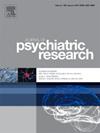Weather's influence on the number of emergency psychiatric visits: myth or reality? A systematic review of the literature
IF 3.2
2区 医学
Q1 PSYCHIATRY
引用次数: 0
Abstract
Background
The influence of weather on emergency psychiatric visits has been explored in various studies, yet the results have been inconsistent. This systematic review aims to investigate the relationship between meteorological factors and visits to psychiatric emergency departments (ED).
Methods
Following PRISMA guidelines, this review aimed to clarify the relationship between meteorological factors and psychiatric emergency visits. A systematic literature search was conducted using the PubMed, Cochrane Library, and PsycINFO databases up until January 2024. The search focused on identifying studies that examined ED visits for psychiatric reasons and investigated the impact of at least one meteorological factor (including temperature, atmospheric pressure, precipitation, wind, humidity, sunlight exposure, or day length).
Results
Of the 191 articles initially screened, 16 were selected for in-depth analysis. Among these, 10 studies found a significant association between higher temperatures and an increase in psychiatric ED visits. Further subgroup analyses revealed a specific correlation between increased temperature and psychiatric ED visits for mood disorders, psychotic disorders, substance use disorders, suicidal behavior, and anxiety disorders. Research on meteorological factors beyond temperature was notably scarce.
Conclusions
The link between increased temperature and psychiatric emergencies could stem from various biological mechanisms, including the modulation of melatonin and serotonin levels. Gaining insights into how weather conditions affect psychiatric ED visits enables a deeper understanding of the triggers for psychiatric decompensations. This information is crucial for developing targeted preventive strategies and informing public health policies aimed at mitigating the impact of adverse weather on mental health crises.
天气对紧急精神科就诊人数的影响:神话还是现实?对文献的系统回顾
各种研究都探讨了天气对紧急精神科就诊的影响,但结果却不一致。本系统综述旨在探讨气象因素与精神科急诊科(ED)就诊的关系。方法遵循PRISMA指南,探讨气象因素与精神科急诊就诊的关系。使用PubMed、Cochrane Library和PsycINFO数据库进行系统的文献检索,直至2024年1月。这项研究的重点是确定因精神原因而去急诊室就诊的研究,并调查至少一种气象因素(包括温度、大气压、降水、风、湿度、阳光照射或白天长度)的影响。结果在初步筛选的191篇文章中,选择了16篇进行深入分析。其中,有10项研究发现高温与精神科急诊科就诊次数增加之间存在显著关联。进一步的亚组分析显示,体温升高与因情绪障碍、精神障碍、物质使用障碍、自杀行为和焦虑症而就诊的精神科急诊科患者之间存在特定的相关性。对气温以外气象因子的研究明显匮乏。结论体温升高与精神紧急情况之间的联系可能源于多种生物学机制,包括褪黑激素和血清素水平的调节。深入了解天气状况如何影响精神科急诊科就诊,可以更深入地了解精神科失代偿的触发因素。这些信息对于制定有针对性的预防战略和为旨在减轻恶劣天气对精神健康危机的影响的公共卫生政策提供信息至关重要。
本文章由计算机程序翻译,如有差异,请以英文原文为准。
求助全文
约1分钟内获得全文
求助全文
来源期刊

Journal of psychiatric research
医学-精神病学
CiteScore
7.30
自引率
2.10%
发文量
622
审稿时长
130 days
期刊介绍:
Founded in 1961 to report on the latest work in psychiatry and cognate disciplines, the Journal of Psychiatric Research is dedicated to innovative and timely studies of four important areas of research:
(1) clinical studies of all disciplines relating to psychiatric illness, as well as normal human behaviour, including biochemical, physiological, genetic, environmental, social, psychological and epidemiological factors;
(2) basic studies pertaining to psychiatry in such fields as neuropsychopharmacology, neuroendocrinology, electrophysiology, genetics, experimental psychology and epidemiology;
(3) the growing application of clinical laboratory techniques in psychiatry, including imagery and spectroscopy of the brain, molecular biology and computer sciences;
 求助内容:
求助内容: 应助结果提醒方式:
应助结果提醒方式:


